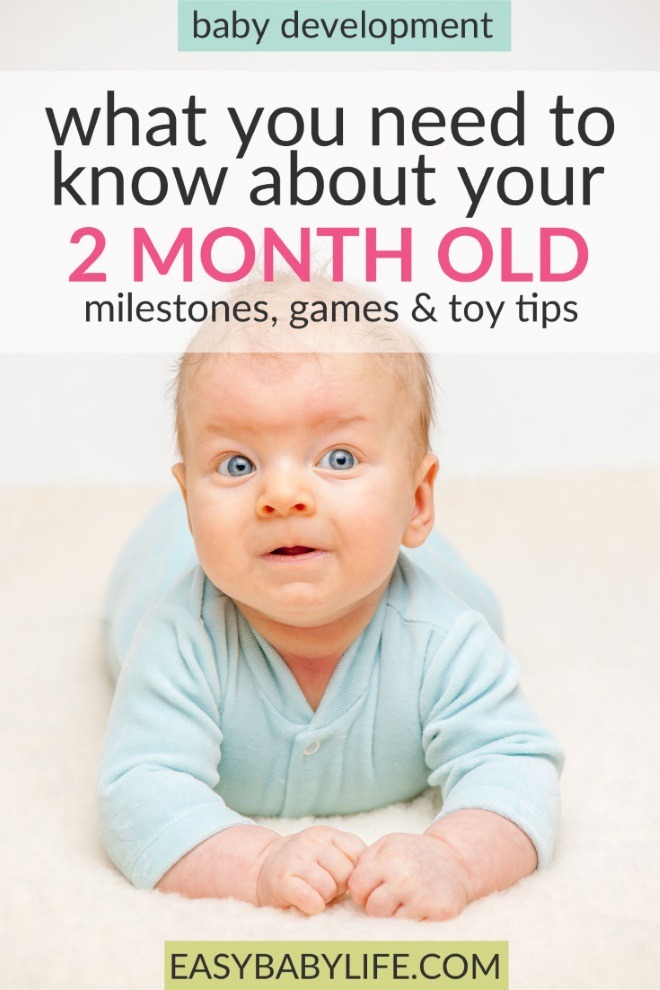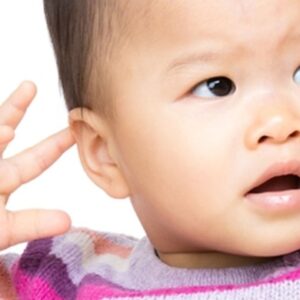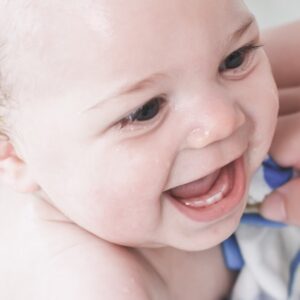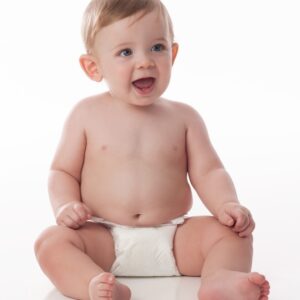At 2 months, your baby is now probably a more social little person; fun! Let’s go through how to enjoy your time together, your 2-month-old baby’s development milestones, red flags, learning activities, and the best toys!

When you have a 2-month-old, you and your baby have been around each other long enough to get to know one another. Maybe you are starting to find it easier to interpret his/her cries, for example.
Having a 2-month-old baby can also mean being DEAD TIRED. Really. Check out my tips for getting more sleep as a new mom.
Now many babies are becoming more social and also use their bodies more and more. Don’t ever leave your baby alone on the changing table!
Now, what can you expect from a 2-month-old?
Not so much yet, but compared to only a few weeks back, his or her vision has improved quite significantly, and he is also likely to have found his hands.
And reaching those milestones, he or she is now ready for some new toys. Trying to reach colorful objects is great fun!
What to Expect from a 2-Month-Old Baby
In this article…
2-Month-Old Baby Development Milestones
Here is how your baby has developed this month:
Physical Development
Weight and Length
The average weight of a 2-month-old baby is 12 pounds and 5 ounces (5.6 kg) for boys and 11 pounds and 4 ounces (5.1 kg) for girls.
When it comes to height/length, the average length for a 2-month-old boy is 23 inches (58.4 cm) and for a baby girl 22.5 inches (57.1 cm).
Keep in mind that every baby is different, and the most important thing is that your baby gains weight and grows at a healthy rate.
The Senses
Vision
Your baby’s vision has improved so much, and your baby starts to find more detailed patterns and colors interesting.
At 2 months, your baby can see your face while feeding. So, smile at your baby a lot.
Her eyes work better in pairs now too, and the cross-eyed look you probably saw sometimes in your newborn baby will not be as common.
By 1.5 to 2 months of age, you should be able to establish stable eye contact with your baby. If your baby can’t focus his eyes or make stable eye contact, be sure to mention this to your baby’s doctor for an assessment. (Research reference here)
Hearing
His hearing is good, and your baby is likely to turn his head toward different sounds to see where they come from.
Your baby particularly enjoys the sound of your voice. Talk to your baby, sing, and read to him. It makes him feel good, safe, and loved.
Motor skills
Movement
Your baby is gaining more control over his body. That also includes having a bit more head control when lifting and holding the head while lying on his tummy.
At 2 months, the baby’s movements are starting to be more purposeful and smoother. However, many movements are still reflexive.
Now that your baby has found his hands and started to get some control of them, he will start putting his hands and everything he holds in them in his mouth. He might also enjoy sucking on his fist or knuckles because the sucking reflex is still strong.
A 2-month-old will also hold his hands open for more extended periods than before. If you give him a rattle, he might grab it.
Gaining control over his body, your baby will start practicing rolling over. Probably not entirely just yet, but maybe from his back to his side, for example. Some babies roll from stomach to back already, but probably not deliberately.
She will also start kicking, stretching her legs, and waving her arms.
Drooling
Your baby might also start drooling a lot. It usually happens because the salivary glands are starting to work, and your baby still doesn’t have the ability to simply swallow saliva.
When your baby drools, make sure to wipe away the drool and dry her face, neck, and chest. When the skin is wet for too long, it might become irritated, and a drooling rash might develop. You can also use a bib to protect her chest and clothes.
It is often believed that this drooling is a result of teething. However, although some babies might start teething this early, it is uncommon. Most babies start teething somewhere around 4 to 6 months.
Cognitive and Social Development
Interaction
A 2-month-old baby is becoming more and more interested in “talking” to people every day. Mom, dad, and siblings are, however, her favorites.
You can now try and lead a back-and-forth conversation with your baby. A 2-month-old will make grunting and cooing sounds. Respond to those by babbling and talking as it teaches your child about language and conversation. When you talk to your baby, you might notice that she makes sounds as a way of trying to respond.
You might catch your 2-month-old smiling to you or other people. Your baby should also start to recognize your face and the face of other family members.
Crying
If your newborn cried a lot, it might cheer you up to know that most babies start crying less at this point (unless they have colic).
Crying usually culminates at around 6 weeks and then subsides.
Don’t expect your 2-month-old to stop crying almost completely, though. At this point, crying is still the primary method of communication for a baby. A baby will still use it to express his needs (hunger, tiredness, diaper change, etc.)
Sleep Pattern
Your baby’s sleep pattern has started to mature, and she probably sleeps more at night than during the day. Now is a good time to start introducing some type of sleep routine slowly.
But you shouldn’t expect your baby to sleep through the night yet, or think that you are doing something wrong if your baby wakes up several times per night.
Waking up for feeding or merely waking up is entirely normal for a 2-month-old!
2-Month-Old Developmental Red Flags
Being a 2-month-old, your baby “should” be able to:
- Lift their head if placed on their stomach
- Open their hands
- Smile back at you
- Talk a little bit (grunting, cooing, etc.)
Even though babies are different and develop at their own pace, some warning signs might point to atypical development. If you notice any of the following signs, talk to your child’s pediatrician:
Your 2-month-old baby:
- Doesn’t focus on objects or follow objects with his eyes
- Doesn’t respond to loud sounds
- Keeps hands closed most of the time
- Doesn’t bring his hands to his mouth
- Can’t lift or hold their head up while lying on his tummy
- Isn’t making sounds
- Doesn’t smile at people
Below is a video that shows normal physical development at two months compared with atypical development and motor delay.
Learning Activities for Your 2-Month-Old
“How can I play with my 2-month-old?” Well, playing with your baby is getting easier all the time as she or he develops new abilities!
Here are some fun things you can do with your baby that are actually good learning activities for your baby, too:
A 2-month-old baby often loves “walking.” She will start moving her legs if you hold her upright on a flat surface. Great fun!
Now is also the right time to help your baby practice reaching out for objects. Hold a toy in front of your baby and encourage her to reach for it.
Your baby may also enjoy the sound of a rattle coming from different directions around him. Make some noise and wait until he has found its source until you move the rattle.
Follow the Fly is another game that my babies have enjoyed. Sit in a chair and pretend that your finger is a fly.
Let it fly around while making a buzzing sound. Let the fly land in different places on your baby and tickle him a little bit. Do this a few times, and then use your baby’s finger instead as the fly.
Don’t forget to practice tummy time with your baby (tips on how can be found here). Lay your baby on the floor a few times during the day so she can practice lifting her head, holding it up, and turning it side to side.
Many babies don’t like tummy time because it is hard work. You can help your baby by putting a rolled blanket or a pillow under her chest or arms to support her. You don’t have to let your baby do tummy time for any long periods! This will only make your baby sad. Do it for a few minutes at a time, and focus on making it a fun and exciting activity!
Best Toys for Your 2-Month-Old
If you haven’t done so yet, buy a baby play gym. You don’t have to buy an expensive one because it will only last as a toy for a few months. (Unless you plan for siblings, of course…)
Anyway, if not yet, your baby will soon be very interested in trying to touch things with her newly discovered hands. Then a baby play gym is great!
If you don’t want to buy anything, hang a few bright items in strings under a chair and place your baby beneath it. That works fine, too, at least for a while.
Now also, brightly colored soft rattles and other toys and pictures start being really interesting.
The 2-Month-Old Baby on Video
In this video, you can see the typical “talking” that many babies of this age really enjoy. Adorable, don’t you think? And now a lot more chubby and the classical baby look than just a few weeks ago.
Where would you like to go next?
You can find all posts about 2-month-old babies here.
And please share something about your 2-month-old by leaving a comment below! :-)
1-month-old baby | 3-month-old baby

Paula Dennholt founded Easy Baby Life in 2006 and has been a passionate parenting and pregnancy writer since then. Her parenting approach and writing are based on studies in cognitive-behavioral models and therapy for children and her experience as a mother and stepmother. Life as a parent has convinced her of how crucial it is to put relationships before rules. She strongly believes in positive parenting and a science-based approach.
Paula cooperates with a team of pediatricians who assist in reviewing and writing articles.






My baby is 2month and my family is mad with me because I won’t let her stay with them. Am I overprotective or not?
You are definitely not! Follow your instincts. You decide. :-) And your baby is still very young!